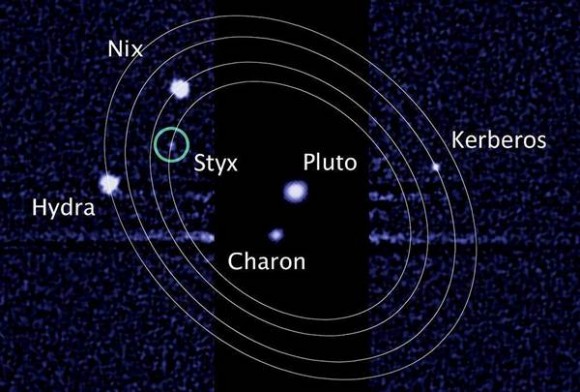 Computer simulation of what a binocular view of Venus (centered) and Jupiter will look like on June 30 (Image Sources: Stellarium, EarthSky.org )
By Glenn A. Walsh
Reporting for SpaceWatchtower
Computer simulation of what a binocular view of Venus (centered) and Jupiter will look like on June 30 (Image Sources: Stellarium, EarthSky.org )
By Glenn A. Walsh
Reporting for SpaceWatchtower
The two brightest planets, as viewed
from Earth in the evening sky, will appear to come extremely
close at the end of the month. In a somewhat rare, close conjunction,
Venus and Jupiter will seem to come within 0.3 degree of each other;
not until August 27 of next year will they to seem to come this close
again. Even now, as June is ending, Venus and Jupiter can be seen
getting closer to each other, each evening after sunset in the western
sky.
While most observers will see the
apparent close approach of the two planets on the evening of June 30,
the actual conjunction (astronomically, the moment when both objects
have the same Right Ascension: 9 hours, 37 minutes), occurs the next
morning. The conjunction of Venus and Jupiter occurs on Wednesday
Morning, 2015 July 1 at 10:00 a.m. Eastern Daylight Saving Time (EDT)
/ 14:00 Coordinated Universal Time (UTC), when Venus will be 0.4
degree south of Jupiter. Of course, the evening of July 1 will also
be a good time to see the aftermath of this conjunction, when the two
planets still appear very close.
So, June 30 – July 1, Venus and
Jupiter will appear so close, the apparent distance between them will
be less than the diameter of viewing the Moon during the Full Moon
phase. You should be able to stretch-out your arm and cover-up both
planets at the same time with your “pinky” finger (now,
that is rare)! In fact, you may have trouble distinguishing the two
planets, separately, unless you use a telescope or binoculars.
Now, this event will occur each
evening, from now through several days after the July 1 conjunction,
as the two planets approach each other then separate after the
conjunction, just after sunset in the western sky each night. Venus,
being much closer to the Sun, always appears either shortly after
sunset or shortly before sunrise.
Venus, being the brightest planet in
the sky, will be very easy to find after sunset. In fact, it is so
bright, that it is common to be able to find Venus a few minutes
before sunset, which some people consider even more beautiful with a
cobalt hue background of the early evening twilight. Being somewhat
dimmer, Jupiter will be seen shortly after sunset, and it will be
easy to find as it will appear as the brightest object just above Venus.
Another relatively bright object will
also be visible in this area of the sky, the Star Regulus. Officially
known as Alpha Leonis (a Leonis), Regulus is the brightest star in
the Constellation Leo the Lion. Regulus will appear above, and a
little to the left of Venus and Jupiter, as you look in the western
sky.
Outside the Sun and the Moon, Venus and
Jupiter are the brightest objects that can be seen in Earth's sky.
Sometimes erroneously referred to as the “evening star,” Venus
outshines any other planet as viewed from Earth for three reasons:
Venus is the closest planet to Earth, it is closer to the Sun than
Earth (second planet from the Sun, while Earth is the third), and
Venus is constantly obscured by clouds which reflect the Sun's light
more intensely than Jupiter's clouds (as Venus is much closer to the
Sun than Jupiter). Venus is so bright, that often people will confuse it for a "UFO" (unidentified flying object).
Astronomers measure the apparent
brightness of celestial objects using a scale known as Visual
Magnitude, which actually was first established by the Greek
astronomer Hipparchus in the second century B.C. (one of the most
famous of the ancient astronomers, his name is inscribed on the
exterior, Indiana limestone wall of Pittsburgh's original Buhl
Planetarium and Institute of Popular Science, just below the
planetarium dome). Visual Magnitudes are a logarithmic scale,
where a change in Magnitude of one equates to a change in brightness
of about two and one-half times. The lower the Magnitude number the
brighter the object. This includes negative numbers. Here are the
apparent Visual Magnitudes of some well-known sky objects --
Sun: - 26.75
Moon at Full Moon Phase: - 13
Venus at its brightest: - 5
Sirius, brightest star in the night
sky: - 1.44
Star Regulus (a Leo A): 1.36
Star Polaris (a UMi A), the “North
Star”: 1.97
Reflections or “Flares” from
Iridium Communication Satellites: - 9
International Space Station: - 6
(Except for stars such as the Sun,
Sirius, Regulus, and Polaris, the brightness from all the others are
from reflected sunlight.)
At the July 1 conjunction, Venus, the
brightest planet in the sky, will measure: - 4.6 in Visual
Magnitude. The Visual Magnitude of the second brightest planet in the
sky, Jupiter, will be: - 1.8. The Visual Magnitudes of the planets
vary, depending on how close they are to the Earth and to the Sun. In
the case of Venus, the brightness also depends on the phase of the
planet (for this conjunction, Venus will be in a “fat” crescent
phase). Both Venus and Mercury, the two planets closer to the Sun
than Earth, have phases somewhat similar to the phases of the Moon.
Most stars, except for variable stars,
have a fairly constant Visual Magnitude. Hence, Regulus will be
shining at a Visual Magnitude of 1.36, as always.
Only about ten hours after the actual
conjunction of Venus and Jupiter, the Moon's Full Moon phase occurs:
Wednesday Evening, 2015 July 1 at 10:20 p.m. EDT / July 2 at 2:20
UTC. And, because this Full Moon comes on the first day of a 31-day
month, the second Full Moon of July is known to some people as a
so-called “Blue Moon,” which will occur Friday Morning, 2015 July
31 at 6:43 a.m. EDT / 10:43 UTC.
More on Conjunctions of celestial
objects:
More on Visual Magnitudes of celestial
objects:
Photo of Hipparchus name inscribed on
exterior wall of Pittsburgh's original Buhl Planetarium and Institute of Popular Science (inscription on right side of photo: southwest
wall):
Source: Glenn A. Walsh Reporting for SpaceWatchtower, a project of Friends of the Zeiss.
Want to receive
SpaceWatchtower blog posts in your inbox ?
Send request to <
spacewatchtower@planetarium.cc
>..
gaw
Glenn A. Walsh, Project Director,
Friends of the Zeiss <
http://buhlplanetarium.tripod.com/fotz/
>
Electronic Mail - <
gawalsh@planetarium.cc
>
SpaceWatchtower Blog: <
http://spacewatchtower.blogspot.com/
>
Also see: South Hills Backyard Astronomers Blog: <
http://shbastronomers.blogspot.com/ >
Barnestormin: Writing, Essays, Pgh. News, & More: <
http://www.barnestormin.blogspot.com/ >
About the SpaceWatchtower Editor / Author: <
http://buhlplanetarium2.tripod.com/weblog/spacewatchtower/gaw/ >
SPACE & SCIENCE NEWS, ASTRONOMICAL CALENDAR:
<
http://buhlplanetarium.tripod.com/#news
>
Twitter: <
https://twitter.com/spacewatchtower
>
Facebook: <
http://www.facebook.com/pages/SpaceWatchtower/238017839577841?sk=wall
>
Author of History Web Sites on the Internet --
* Buhl Planetarium,
Pittsburgh:
<
http://www.planetarium.cc >
*
Adler Planetarium, Chicago:
<
http://adlerplanetarium.tripod.com
>
* Astronomer, Educator, Optician John A. Brashear:
<
http://johnbrashear.tripod.com >
*
Andrew Carnegie & Carnegie Libraries:
<
http://www.andrewcarnegie.cc >
* Civil War Museum of Andrew Carnegie Free Library:
<
http://garespypost.tripod.com >
*
Duquesne Incline
cable-car railway, Pittsburgh:
<
http://inclinedplane.tripod.com
>
* Public Transit:
<
http://andrewcarnegie2.tripod.com/transit
>




